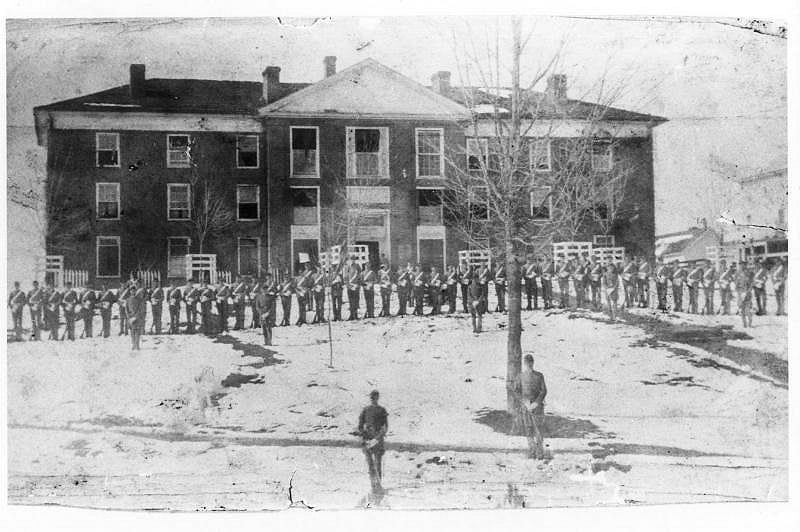James Shockley

Blacksburg and Virginia Tech are so closely intertwined that many people identify them as a single entity.
It is almost as if they were tied together and dropped down by a heavenly parachute. The story about how Blacksburg, probably considered a “nothing” town, wound up with a major educational institution is the subject of two articles in the Smithfield Review by Clara B. Cox, referenced at the end of this article.
Methodists have supported education from the earliest days of the denomination. In the 1840’s a school for girls was founded in Blacksburg. Several years later the local Methodists decided to start a comparable school for boys.
About 1850 the Olin and Preston Institute opened its doors. It was named for Stephen Olin, a prominent Methodist educator and first president of Randolph Macon College, and William Ballard Preston of Smithfield Plantation, a lawyer, statesman and former legislator.
The Civil War caused the most of the Protestant denomination, including the Methodists, to split according to regional boundaries. Meanwhile, the Olin and Preston Institute closed due to the turmoil of the war. When the war ended, the regional splits in the denomination continued, and both groups of Methodists had claims on the Blacksburg school.
To resolve the issue the trustees of the Institute did some maneuvering, part of which involved changing the name of the Olin and Preston Institute to the Preston and Olin Institute.
In 1868 a young Methodist minister, Peter Whisner, was named the preacher of the Blacksburg church with the understanding that he would also teach at the Preston and Olin Institute. This was something of a reward for Whisner who had played a part in retaining the building for the southern Methodists.
In 1870 Virginia became eligible for a federal land grant to develop a college concentrating on agricultural and mechanical studies. Immediately the rush was on with more than 20 colleges, including the University of Virginia, applying to the state legislature for the chance to be transformed.
Peter Whisner got together with Harvey Black, the Rector of the Board of Trustees of Preston and Olin and one of the most prominent citizens of Blacksburg, and they influenced the Board to apply for the land grant – after all, they actually had a building that could be used.
They approached their State Senator, John Penn, who agreed to help and suggested that they might have a better chance if they could raise $20,000 to support the new college. $20,000 in 1870 was worth approximately $360,000 in current funds, a sizable amount in the days of poverty after the Civil War.
Whisner and Black got the county to float a bond issue, raised the $20,000 for the new college, and then left matters up to Penn and General Gabriel Wharton, the local representative in the Virginia House of Delegates. Penn and Wharton presented bills to locate the new college in Blacksburg and fought them through the various committees and the two full chambers of the legislature.
In 1872 the Virginia Agricultural and Mechanical College (VAMC) opened its doors to 132 students in the old Preston and Olin building.
About that time, major changes started in Blacksburg. The town received an official charter from the state, elected a mayor and town council, constructed sidewalks of crushed stone, and assigned street numbers to houses. (Street numbers were not needed when everyone knew everyone else.) Streets were renamed to honor historical personages, such as Washington, Clay, and Jackson. Two streets were named for Penn and Wharton.
The Methodists did not believe in long appointments for their preachers, and Whisner was transferred after three years, leaving before students started coming to VAMC.
He went on to distinguish himself both as a preacher and a church administrator. One year after his death in 1906, on the occasion of a new building, the Blacksburg Methodist Church changed its name to the Whisner Memorial Methodist Church in his honor. The Whisner Building is still part of the Blacksburg United Methodist Church campus.
Harvey Black continued his public life by serving several terms in the Virginia House of Delegates. Later he was named Superintendent of the state mental institution in Williamsburg and still later Superintendent of the new mental institution in Marion where he died from prostate cancer.
Most of the information in this article is based on the articles by Clara B. Cox. These are:
The Smithfield Review, Vol. 19, 2015, “The Early Days of Virginia Polytechnic Institute and State University Part I,” 51 – 76;
The Smithfield Review, Vol. 20, 2016, “Olin and Preston Institute: The Early Days of Virginia Polytechnic Institute and State University Part II,” 1 – 26.
To learn more about Peter Whisner, see the following article by Paul L. Nichols:
The Smithfield Review, Vol. 19, 2015, “Peter Harrison Whisner, D.D”, 33 – 50.
— James Shockley writes a monthly history column. He lives in Blacksburg.



